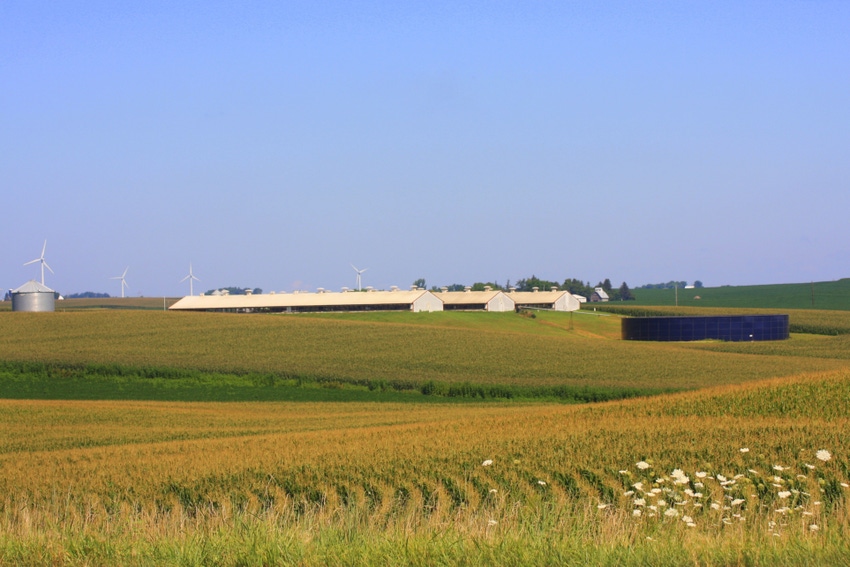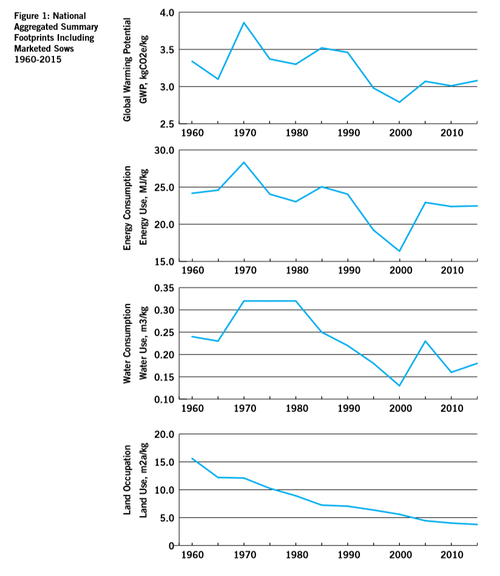U.S. pork sector producing more pork while using significantly lower resources.
January 9, 2019

U.S. pork production increased 84% from 1960 to 2015, but a new study from the University of Arkansas has revealed that the inputs needed to produce a pound of pork in the U.S. have become more environmentally friendly over this period.
The study, “A Retrospective Assessment of U.S. Pork Production: 1960 to 2015,” shows that America’s pig farmers are producing a product that has become increasingly sustainable over the past five decades. Specifically, it took 75.9% less land, 25.1% less water and 7.0% less energy. This also resulted in a 7.7% smaller carbon footprint for the industry. 
“The study confirms what we, as producers, have been doing to make good on our ongoing commitment of doing what’s best for people, pigs and the planet, which is at the heart of the industry’s We Care ethical principles,” said Steve Rommereim, National Pork Board (NPB) president and a pig farmer from Alcester, S.D. “It’s a great barometer of our environmental stewardship over the years and gives us a solid benchmark for future improvements.”
The pork checkoff-funded study took a comprehensive life-cycle assessment approach and used the best available methodology as well as a field-to-farm-gate approach. This meant including material and energy flows associated with the full supply chain, beginning with extraction of raw materials through the production of live, market-weight pigs, including marketed sows. Unlike previous studies, NPB said the research accounts for global warming potential and the use of dried distillers grains in many swine rations.
“This report’s accurate methodology can clearly be seen when you see specific events, such as a sudden spike in mortality rates due to a national disease outbreak, a drought or a change in feed rations,” said Dr. Dave Pyburn, senior vice president of science and technology for the pork checkoff. “This level of accuracy offers a lot of transparency on a yearly basis as to what may negatively affect certain sustainability metrics and could help us find solutions to prevent or mitigate them in the future.”
As it has for decades, NPB said the U.S. pork industry will continue to make strides in overall efficiency, which is the major driver behind improving sustainability across all metrics. This may be achieved through things like nutrition, genetics, health management, crop management, overall technology adoption and more.
The ongoing positive trend is clearly seen in the new study, according to NPB. For example, the report showed that feed conversion (pounds of feed needed for a pound of pork gained) started at 4.5 in 1960 and ended at 2.8 in 2015 – a 38% improvement.
“Consumers may be surprised at how much progress America’s pig farmers have made in sustainability over the years,” Rommereim said. “We not only want them to know that we’ve got a good track record but that we’re not satisfied with the status quo. We plan to use the information to produce an even more sustainable product in the future.”
Because feedstuffs make up the biggest part of pork’s sustainability footprint, NPB recently signed a memorandum of understanding with the United Soybean Board and the National Corn Growers Assn. aimed at improving sustainability. The three organizations will cooperate to conduct research directly related to the environmental sustainability indicators of carbon (greenhouse gases), water use, land use, water quality and soil health.
“It’s important for us to look for partners who will collaborate with us to find new ways to make U.S. pork even more sustainable in the years to come,” said Brett Kaysen, assistant vice president of sustainability for the pork checkoff. “We plan to build on the past decade of the We Care initiative by making its ethical principles more visible to the public. Our goal is to increase the understanding of the true commitment that America’s pig farmers have to improving sustainability.”
Regarding the study results, Bob Langert, president of Mainstream Sustainability and advisor to the pork industry on sustainability issues, said, “The past progress is commendable, but what really impresses me is how the pork industry is stepping up the future. It’s taking on sustainability in a very proactive and strategic way. The feedstuffs partnership is a prime example. So is the recent announcement to elevate its We Care program as its sustainability framework. To me, this represents an enlightened industry that sees sustainability as an opportunity, ultimately to sell more pork.”
You May Also Like



